View current page
...more recent posts
not intended for RSS readers
Update: A 2 MB GIF of this grid is here. See next post or comments.
Cat Bus YouTubes by Anthony Leslie (aka CatBus4U):
#1
#2
#3
#4
All are great--my neighbor Totoro meets Paper Rad meets your 3rd grade nephew with compression-mushed MSPaint pixels in lieu of vector graphics. And great sound. YouTube commenter Chuck2dun is stingy in his praise, however: "At second 'three' [of vid #4] where you have the cat turn its head INSIDE the unchanging head shape is very good. The effect is arresting. I also prefer the black and white to the color. Have you thought about using lower chroma colors?" (hat tip guthrie)
"Tesseract Ranch" [mp3 removed]
My contribution to the tech house genre. This is all live hardware sequenced (no overdubbing) with some EQ and reverb added after the fact.
Update: I substituted the "dry" mix of this--no EQ or reverb. The effects were "bodying up" the sound at the expense of some of the DSP nuances.
1987 - Chris Burden's All the Submarines of the United States of America
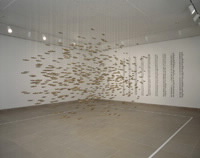
2006 - Fiona Banner's Parade
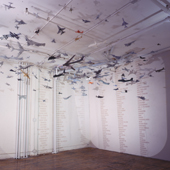
Thanks to Sally McKay for making me aware of Banner's collection of modeled fighter aircraft from all over the world, which will be shown soon in Toronto. It's the latest in our ongoing "attack of the clones" series.
Updated re: installation schedule.
"Tesseract Farm" [mp3 removed]
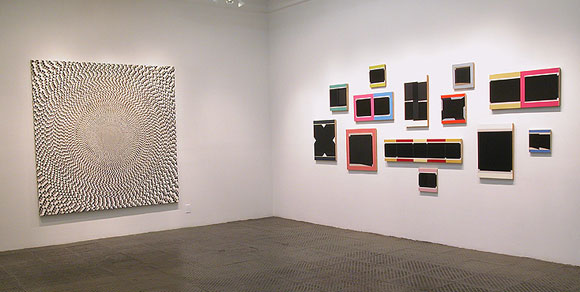
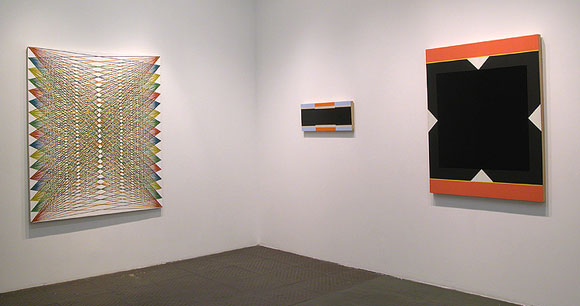
I am going to see this show later today--Mark Dagley (left images) and Don Voisine (right images) at McKenzie Fine Art, 511 West 25th Street in Chelsea. It's the last day of the exhibit, sad to say. An earlier post on Dagley is here. This current show with Voisine is reviewed in the New York Sun--nice, but I wouldn't stop with physical analysis of the work. Doesn't it look like Voisine is censoring his own paintings?
Update: one invigorating thing about the Dagleys in person is the Stella-esque what-you-see-is-what-you-see quality. The bottom one has a white ground and each line is a thick painted stripe connecting two points. The top one is thousands of circles drawn by hand in pencil and then filled in. It's a weird combination of cabalistic arcana, prison art, and the Bauhaus. As much as I enjoyed Marc Handelman's show at Sikkema Jenkins (a Bleckneresque young Turk out of Columbia who has all the advantages of art world virginity) it seemed flashy and overeager to please compared to Dagley's work, which is dazzling yet unassuming, and not as conservative as our two world weary critics might consider it (you know who I mean). As for the Voisine, Mark used the word redaction in the comments and that is the first thing the black bars bring to mind, even though in person you see a play of edges and surfaces in all those blacks. I'm personally not uncomfortable with references to office/bureaucratic culture in art and feel like the self-cancellation of those Xs and black bars gives the work an interesting psychological edge, though it was probably not intended--the paintings are handsome and thoughtful but serious about the rhetoric of painting.
The panelists for an upcoming College Art Association discussion on "Emerging Artists, Critics, and the Market" are Jeffrey Deitch, Don and Mira Rubell, Peter Plagens, and Jerry Saltz. According to an email from AICA, the critics' association organizing the event at the Hilton on Feb 17, among the questions to be addressed are:
In the current situation what, indeed, is the criticís role and responsibility? Are there opportunities? Are there ways to respond and to act that circumvent the conventions of build-a-reputation/trash-a-reputation? What is the relationship between collectors and dealers? How does it work? Why do art world systems go unanalyzed and uncritiqued by most critics? Is there room for critics to deepen the discourse? If so how? Does it make a difference if critics expose the issues within the market, art-making and criticism? Is anyone listening? Can dealers, collectors and artists listen to critics or only to one another? Is there anything critics learn from collectors and dealers? Does it matter? Are artists so caught up in the dazzle and anxiety of early success that they canít hear what they have to know or should a critic attempt to reach them with reasoned argument?
I quit going to these types of panels after a prominent critic told me "we can't discuss specific artists because collectors will rush out and buy them up." Here is an alternative set of questions:
1. What new forms of art have emerged since the '70s? Who are the best artists working today?
2. Have we had a "brain drain" in the art world since the days when Leo Steinberg, Rosalind Krauss, and Craig Owens wrote about their contemporaries (i.e. since about 1982)?
3. Is the art world's dedication to a relative handful of canonical (i.e., marketable) artists comparable to the "copyright tyranny" of Disney and other large corporations?
4. Won't blogging and other forms of online writing largely replace print criticism in the near future? (The publisher of the New York Times seems to think so.) How will that change art practice?
Update: Added Timesman's prognostication and link.
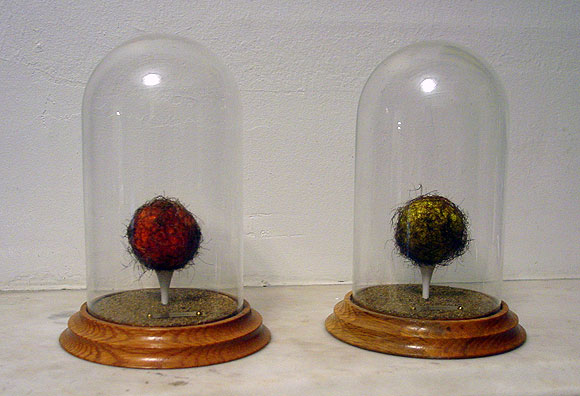
A work from my personal collection: The Art Guys' Goatee Off, ca. 1990. It's documentation of a performance piece where the Houston-based artists grew goatees and played a round of golf, shaving bit by bit as a way of keeping score (go tee off, get it?). Their beard hair is what you see glued to the golf balls. Meret Oppenheim, drink your tea.
